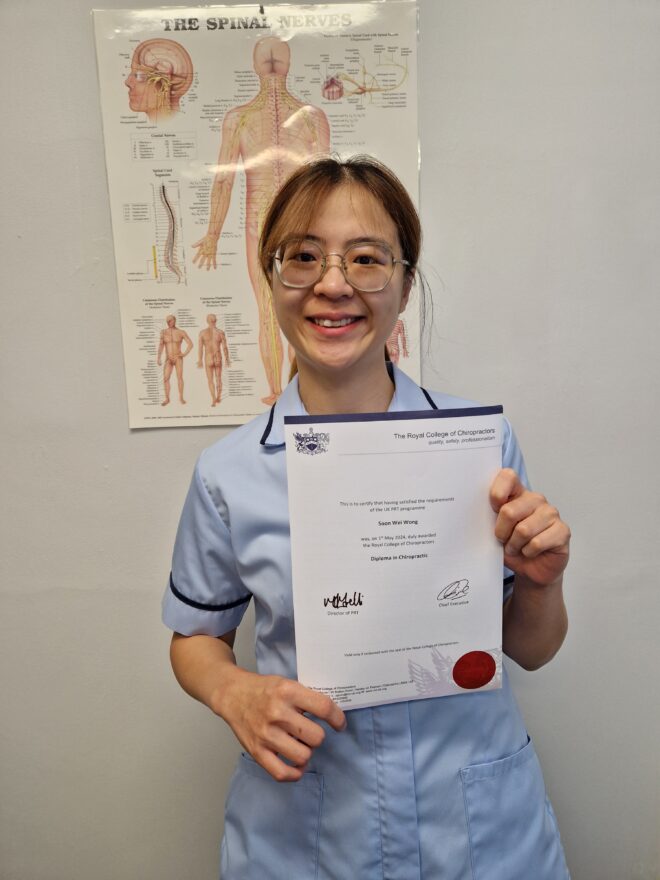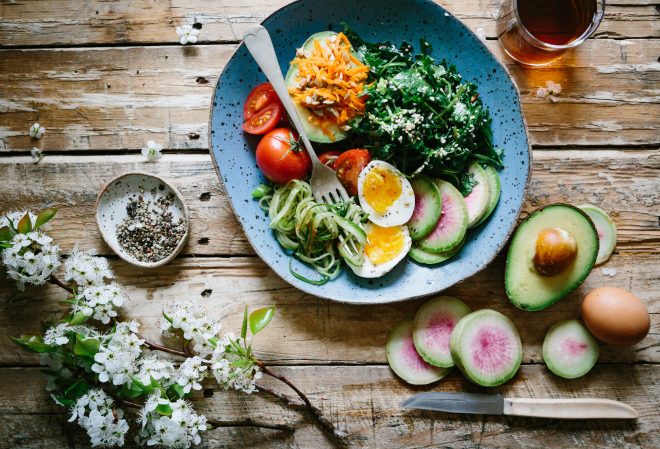
Clinic News
As we make the most of these spells of glorious sunshine - be careful that you do not over exhurt yourself on one task in the garden. As we suggest time and time again, you must mix it up and vary your posture while working, take regular breaks, warm up before you start and stretch out afterwards to minimise those gardening aches and pains.
Erin finally gets her Royal College of Chiropractic PRT certificate and Sophie is dominating the medals table with her achievements in the regional shot put and discus events.
Alex will be taking some time off at the end of the month so don't forget to get an appointment booked in good time. Remember we are running the 'buddy system' now; ie your care is co-managed by another chiropractor at the clinic. So don't suffer if you need support if your chiropractor is unavailable.
This month we will share some top tips on gardening and getting the most out of your holiday.
As our students are mid-exams now - we wish them luck on their final few weeks

Warm Wet Weather Can Bring Pain
When there is wet weather during the summer months, plants and grass thrive and, if you have a garden, it can seem like you need to mow and weed nearly every weekend. This can lead to aches and pains and even injury unless you take precautions.
People suffer from aches and pains when they undertake what seems to be a relatively sedate activity such as gardening. The actions required are quite different from those carried out in the rest of the year.
The main causes are prolonged stretching and overuse of the ligaments and joints in the spine. Digging, mowing and stooping place considerable stress on the ligaments and joints in the lower lumbar spine and cause them to become inflamed and tender. This will trigger a protective muscle spasm which gives rise to the deeper, duller, achy type of pain that occurs over the following few days.
This happens year after year. It is very important to look after your muscles and joints, especially when undertaking a form of exercise that you are not used to. If you want to stop gardening aches and pains and be able to appreciate all the hard work the next day, then follow these top ten tips:
1 Gently stretch your muscles and ligaments for a few minutes before and after gardening, but don’t bend down to touch your toes – this can cause damage
2 Wear light, but warm clothes & make sure your lower back is always covered
3 Kneel on one leg rather than bending your back repeatedly
4 Use long handled tools to prune tall plants
5 Use only a small spade/fork for digging and keep your back gently hollowed
6 Do not always work to one side only, vary your position
7 Don’t do the same work for long periods, vary your tasks
8 Keep your back straight when carrying
9 When finished have a warm bath or shower
10 Do not sit for too long in your favourite armchair afterwards, but stand up regularly and walk around for a minute or two

Don\'t Let Back Pain Spoil Your Holiday!
Think of holidays and most people will dream up images of days spent having a good time, perhaps relaxing in the sun or pursuing new interests. But how many people would wish to imagine themselves lying down indoors with back pain?
Unanticipated injury, such as back pain, can spoil a good holiday – don’t let it spoil yours. Aim to reach a good level of fitness before you go away, and when taking part in sports, make sure you know how play them properly.
Whatever physical activities you choose to engage in, bear in mind that a good number of back complaints are offset by failing to warm up properly before exercising.
Different sports have different guidelines as to how you should take care of your back. For example, when swimming it’s important not to try to keep the whole of the head out of the water, as this places considerable strain on the neck and shoulders, which can lead to problems in the lower back
Golf can present its own problems, particularly if the muscles aren’t warmed up before hand in order to cope with the rotation (twisting) of the lower back when swinging the club. Prevent this by practicing stretching and flexibility exercises before playing.

Good nutrition for bones muscles and joints
Choosing a balanced diet containing the right vitamins and minerals decreases our chances of developing deficiencies later on in life. Try this healthy diet plan for optimum bone, muscle and joint health.
A Healthy Diet Plan
Calcium
For bone, muscle and joint health try and include calcium in your diet, which is essential for optimal nerve and muscle function and blood clotting.
Obtained from:
Dairy products are rich in calcium that is easy to absorb. Non-dairy sources with equally absorbable calcium are green leafy vegetables from the kale family. Spinach, rhubarb, sweet potatoes and dried beans are rich in calcium, but from these foods it’s not so easily absorbed.
Magnesium
Required for efficient muscle contraction and conduction of nerve impulses. Low magnesium levels in the body can affect the body’s calcium levels, putting bone health at risk.
Obtained from:
Green leafy vegetables, unrefined grains and nuts. Small amounts are present in meat and milk. Large quantities of fibre in the diet and low protein intake can reduce the amount of magnesium able to be absorbed by the body.
Vitamin D
Essential for regulating the formation of bone and the absorption of calcium from the intestine. Vitamin D is a fat-soluble vitamin that functions to help control the movement of calcium between bone and blood.
Obtained from:
Primarily from the action of UVB light (sunshine) on the skin. Food sources such as cod liver oil, sardines, salmon, tuna, milk and milk products contain small amounts of Vitamin D.
Vitamin C
The structure of bones, cartilage, muscles and blood vessels is provided in part and maintained by collagen. The formation of strong efficient collagen requires Vitamin C.
Obtained from:
Citrus fruits, berries, tomatoes, cauliflower, potatoes, green leafy vegetable and peppers. Also important for producing strong collagen and therefore strong bone structure is Folic acid. Folic acid is found in cereals, beans, green leafy vegetables, orange and orange juice.
Antioxidants
Vitamin C is also a strong antioxidant and is capable of regenerating other antioxidants like vitamin E. The role of antioxidants is to mop up free radicals (the by-products of normal metabolism). Excessive amounts of free radicals cause damage to joint surfaces and muscle cell regeneration. Antioxidants reduce the potential of these free radicals to cause joint damage.
Obtained from:
Antioxidants are vitamins A, C, E and the mineral selenium and are present in fruits and vegetables, the highest quantities are found in the most deeply and brightly coloured. The cartilage that lines the articulating surfaces of all joints is critical to joint health. Cartilage is the shock absorber of joints and is continually rebuilt if a source of raw materials is available. Supplements such as glucosamine sulphate can be added to a healthy diet to assist joints that may be showing signs of wear and tear.
Essential fatty acids
Essential fatty acids (EFAs) also reduce the degenerative changes in tissues and cells and help guard against some cancers. EFAs are unsaturated fatty acids. They aid in decreasing the inflammatory response and help relieve pain and discomfort in joints and muscles.
Obtained from:
EFA’s, such as Omega 3, can be found in oily fish, (sardines, herrings, mackerel), and seeds.
Foods to avoid…
There are certain foods and substances that adversely affect the body’s use of minerals and vitamins. High saturated/animal fats, refined foods, white flour, white sugar, white rice, chocolate, carbonated drinks and fruit juices with high sugar concentration should be kept to a minimum if not weaned from the diet completely. Meat and dairy products should be kept within a recommended weekly amount. Dairy products such as calcium sources should be varied with other non-dairy sources.
We treat all conditions that affect any muscle or joint in your body, from your head to your little toe! One of the most common complaints that we treat is back pain and Chiropractic is recommended by the government authority, the National Institute for Clinical Excellence (NICE) for acute and chronic back pain. Some of the other conditions that we treat are neck and headache, shoulder pain, leg and hip pain, knee and foot pain, sciatica and arthritis. Our registered Chiropractors all have at least five years of training. Treatment costs can be covered through most health insurers. If you are in any doubt, we are always very happy to talk with you on the phone to see if your condition will respond well to Chiropractic treatment. Call the clinic now to arrange an appointment time that works for you. 0115 9225085 If you would like to opt-out of receiving these newsletters please follow the unsubscribe link below, email alex@beestonchiropractic.co.uk or let us know at your next appointment.




